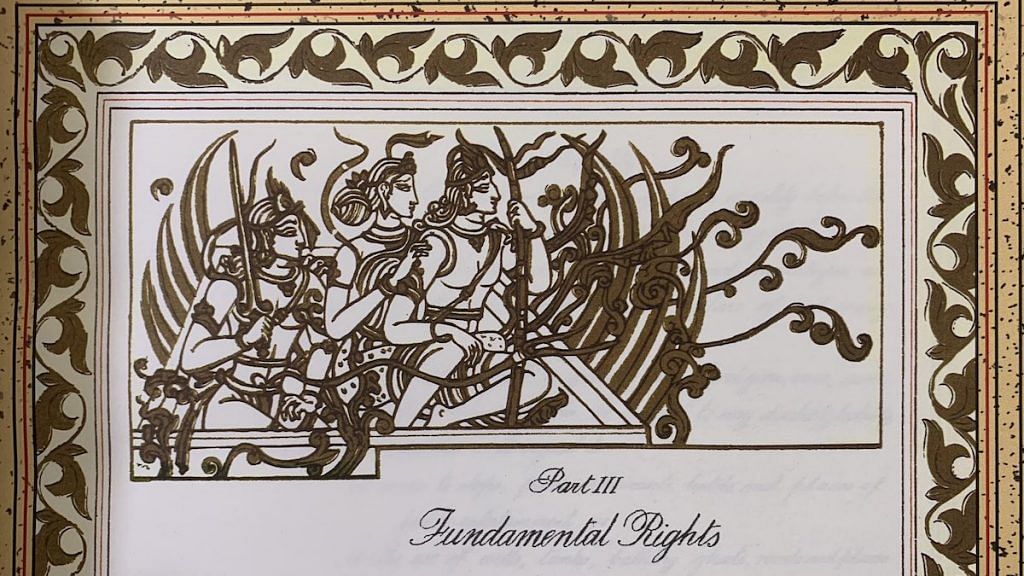When the writing of independent India’s new Constitution was in its final stages in the Constituent Assembly, a detailed discussion regarding the various artworks in the original copy took place soon after the final draft presented by Dr Bhimrao Ambedkar was passed. Following a unanimous decision, famous artist Nandalal Bose of Santiniketan was authorised to oversee the artworks. Bose and his team selected various paintings and drawings depicting the saints, gurus, rulers and mythological characters from Indian history to decorate parts/sections of the Constitution. Each of these drawings and paintings expressed a unique message and purpose of India’s infinite heritage and legacy.
In Part III of the Indian Constitution, which describes our Fundamental Rights, there is a painting of Shri Ram, Sita ji and Lakshman ji. It is important to understand why Shri Ram’s image is the most appropriate choice for this part of the Constitution. As soon as the Indian Constitution came into force, all its citizens received their fundamental rights. This was the first time after nearly 800 years of foreign rulers that the entire nation had gained independence in a systematic manner. With these fundamental rights, Indian citizens were granted freedom from all kinds of discrimination. As per the Right to Equality clause in Article 14 of the Constitution, everyone, whether rich or poor, powerful or weak, hold equal rights before the Constitution and the law. Furthermore, by the provisions contained in Article 15, the state and its agencies as well as non-state institutions and individuals, are obligated to treat citizens equally.
In Article 21, under the ambit of ‘Right to Life’, everyone not only has the right to live with human dignity but also entitled to a dignified funeral after death. The ‘Right to Equality’ also states that in the event of any dispute, every person holds the right to present their case in the judicial process. Thus, rather than being subjugated to any single authority or individual, the Constitution is an independent and sovereign custodian of the rights of Indian citizens.
Also read: In Ambedkar’s ‘Proposed Preamble’ to Indian Constitution, there was no ‘equality’ clause
Shri Ram’s nature in sync with human values
Shri Ram’s generous and impartial personality is known to all. Apart from this, the concept of ‘Ram Rajya’ – which is considered as a paradigm of good governance – imbibes this spirit of human life. In various versions of the Ramayana and other folktales, we get numerous glimpses of Shri Ram’s human emotions and empathetic attitude towards people that are perfectly in sync with the values of our Constitution today. In that time and era, without any caste discrimination, Shri Ram befriended Nishadraj, who was considered as a lower caste. He was accorded the same respect that was bestowed on his other royal friends. Rejecting apartheid or racial discrimination, Shri Raghunandan also graciously accepted the semi-eaten plums offered by a tribeswoman Mata Shabari, that time. As a king, Shri Ram was a true guardian of people’s rights, treating all those under him as equals.
Similarly, after killing his enemies and opponents like Ravana and Tadka in battles, Shri Ram ensured their funerals with full honour. When he learnt that his father King Dasaratha had announced his coronation, he first wanted to know what had been decided for his three brothers. He believed that his brothers also had equal rights to the Kingdom of Ayodhya and they should also get equal share.
In another context, Shri Ram had blessed transgenders after accepting their reverence for him. Even during battles, he provided shelter to the messengers and followers of the enemy state and assured protection to them. When Vibhishan came to pay a visit, Sugriva warned Shri Ram that he is the brother of the enemy. In response, Shri Ram explained to Sugriva that listening to and protecting the views of every person who comes seeking justice is part of his basic nature as well as his duty.
According to the prevailing system and custom of that time, he himself was bound to his rajdharma and religious duty, which you can compare with today’s expression ‘rule of law’. Even after being omnipotent, extremely popular and a powerful king, Shri Ram never violated the prescribed rules nor did he ever keep himself above religion.
Also read: Tagore’s ‘Ramrajya’ didn’t have one Rama. Hindutva soldiers should know that
What is Ram Rajya?
When we aspire for Shri Ram’s rule, we mean ‘Ram Rajya’, not ‘Ramraj‘. Good governance is proof of the success of a king or ruler. But there is a difference between the success of ‘Rajya‘ (state) and the success of a limited period of a king’s ‘Raj‘ (tenure of rule). Even the foundations of ‘Ram Rajya’ were laid when Shri Ram himself was in exile and not physically present in Ayodhya. His footwear was symbolically placed and Ayodhya was administered for 14-years with due respect to Shri Ram’s ideals. The true meaning of Ram Rajya is in the establishment of a well-protected, prosperous, progressive and positive state for the welfare of people. Similarly, we have not confined our Constitution to the limits of a person-centric ‘Raj’. Instead, the Indian Constitution establishes a ‘people-centric’ republic state — one that truly reflects Shri Ram’s ideals.
It would not be wrong to acknowledge that India’s cultural, moral and political values and ShriRam’s personality and philosophy of life are homogenous to our constitutional values.
Tejasvi Surya is Lok Sabha MP and National President of Bharatiya Janata Yuva Morcha. Suyash Pande is an Advocate, Supreme Court. Views are personal.
